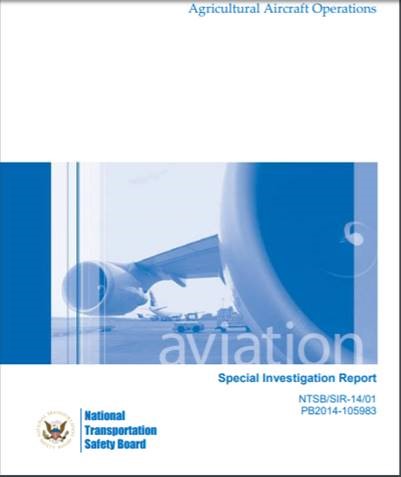 Early in 2014,
the National Transportation Safety Board (NTSB) released special investigation
report (SIR) number SIR-14/01 detailing investigations of 78 ag accidents that
occurred during 2013. All of these accidents involved some aspect of
agricultural operations, pilot training, or other crop protection activities.
Not all these accidents occurred during a part 137 operation but were tied to
the ag industry close enough to warrant investigating their causes.
Early in 2014,
the National Transportation Safety Board (NTSB) released special investigation
report (SIR) number SIR-14/01 detailing investigations of 78 ag accidents that
occurred during 2013. All of these accidents involved some aspect of
agricultural operations, pilot training, or other crop protection activities.
Not all these accidents occurred during a part 137 operation but were tied to
the ag industry close enough to warrant investigating their causes.
NAAREF submitted
a third follow-up
letter during June 2018 to inform the NTSB of the actions being
taken on the Board’s safety recommendations. Detailed information on the NAAREF
response was reported in the June
14, 2018 eNewsletter. Last week NAAREF received a letter from the
NTSB regarding our handling of Safety Recommendations A-14-28 through -31. The
letter from the NTSB can be read in detail by clicking
here.
The
recommendations and their comments on the recommendations are listed below:
A-14-28. Guidance for fatigue management is
lacking for agricultural aircraft operations, and such guidance could help
operators and pilots develop effective strategies to reduce the likelihood of
fatigue, dehydration, hunger, and other physiological factors that can
negatively affect a pilot’s concentration, decision-making, and performance.
NTSB responded
that the topic of fatigue in ag aviation was covered with the help of a
specialist in sleep medicine in addressing topics such as recognizing and
coping with fatigue, medical symptoms of fatigue, dangers of fatigue,
importance of sleep, common misconceptions about sleep aids, fatigue mitigation
practices for agricultural operations, and circadian rhythm. A fatigue module
was produced for the 2015-2016 PAASS Program; a fatigue brochure titled
“Combatting Fatigue in Agricultural Aviation”; and magazine articles were
published. NTSB stated that these actions satisfy the intent of Safety
Recommendation A-14-28 which it now considers “Closed—Acceptable Action.”
A-14-29. Risk management guidelines and best
practices specific to agricultural aircraft operations are necessary tools to
help operators and pilots mitigate the unique risks associated with their
operation. Risk management is a decision-making process by which pilots can
systematically identify hazards, assess the degree of risk, and determine the
best course of action.
NTSB responded
that on the topic of risk management, NAAREF presented a module in the
2016-2017 PAASS Program on agricultural operations-specific risk assessment and
mitigation strategies that addressed this recommendation. These topics were in
multiple Fly Safe safety alerts and Agricultural Aviation magazine and a
video was produced about the hazard of operating in low-level airspace.
On December 21,
2017, the FAA informed NTSB that they intended to publish a Safety Alert for
Operators (SAFO) on this topic. NTSB responded that pending the completion and
distribution of the SAFO, the Safety Recommendation A-14-29 remains classified
“Open—Acceptable Response.”
A-14-30. A resource that contains detailed
information related specifically to agricultural aircraft inspection,
maintenance best practices, and quality assurance can reduce the likelihood
that unsafe practices may be introduced and perpetuated.
NTSB responded
that during the 2017-2018 PAASS Program, NAAREF presented a human factors
module that included a discussion of accidents in which improper maintenance
was a safety issue, and identified best practices for conducting effective
aircraft inspection and maintenance quality assurance. These topics were also
featured in various Fly Safe and Agricultural Aviation magazine articles.
On June 29,
2018 the FAA notified NTSB that they had published Information for Operators
(InFO) 17016, titled “Agricultural Aircraft Inspection and Maintenance Quality
Assurance Programs,” which provides guidance for ag operators on maintenance
quality assurance and inspection programs. NTSB responded that the actions
taken by NAAREF, along with FAA’s InFO satisfy Safety Recommendation A-14-30,
which is classified “Closed—Acceptable Action.”
A-14-31. Standards and procedures are essential
for safe operations. Without a resource that contains detailed information
related specifically to agricultural aircraft operations, knowledge and skills test
topics in existing FAA guidance materials, unsafe, nonstandard practices can be
introduced and perpetuated.
NAAREF reported
to NTSB that it is working with the FAA to develop guidance on Part 137
knowledge test subject areas and skills-test items. The guidance we develop
will include reference material and a checklist which will be distributed to
industry via the PAASS Program, Agricultural
Aviation magazine, e-newsletter articles and the NAAA website.
FAA notified
NTSB that they have updated AC 137-1B to include information on the knowledge
and skills test. They also updated their Order 8900.1 guidance for FAA inspectors
on administering these tests. NTSB responded that pending the development and
distribution of the reference material and checklist, Safety Recommendation
A-14-31 remains classified “Open—Acceptable Response.”
Please join
with NAAA, NAAREF, FAA and NTSB to reduce accidents and make ag aviation a
safer place in which to work.